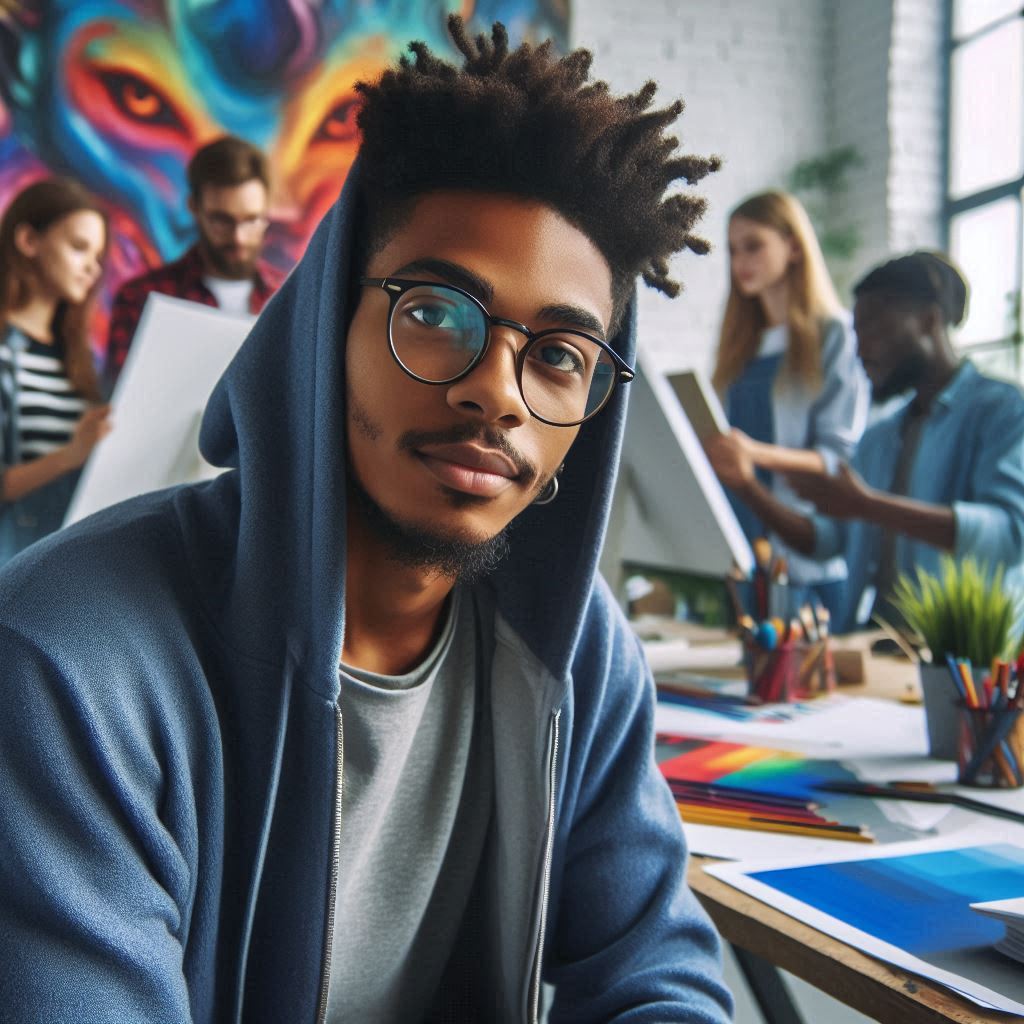Introduction
Art conservators and restorers play a crucial role in preserving cultural heritage.
They analyze and treat artworks, ensuring their longevity.
These professionals examine materials, techniques, and conditions of various art pieces.
They use scientific methods to identify deterioration causes and recommend appropriate treatments.
Conservation involves cleaning, repairing, and stabilizing artworks.
Restorers carefully restore damaged pieces to their original state, using ethically sound methods.
They document each step of their process to maintain transparency and accountability.
Art conservation is vital for several reasons.
It protects invaluable cultural artifacts for future generations.
By preserving art, conservators safeguard historical narratives and enhance our understanding of human creativity.
Moreover, conservation contributes to national identity and pride.
Communities connect with their heritage through preserved art, fostering appreciation and respect for history.
Without proper conservation, artworks face deterioration and potential loss.
In short, art conservators and restorers ensure that our cultural heritage endures.
Their work not only saves art but also enriches our collective history.
Investing in art conservation benefits society by preserving our shared past.
Education and Training
Academic degrees and certifications required
Becoming an art conservator or restorer requires a solid educational foundation.
Most professionals start with a bachelor‘s degree in art history, fine arts, or a related field.
This degree provides essential knowledge about different art movements and techniques.
Additionally, many art conservators pursue advanced degrees in conservation.
A master’s degree in conservation is often necessary for specialized roles.
Specialized training in art history, chemistry, and conservation techniques
Academic programs for conservators typically include both theoretical and practical components.
Students learn about art materials, techniques, and preservation methods.
They study the chemistry of art materials to understand how they age and deteriorate.
This knowledge helps them make informed decisions during conservation projects.
Furthermore, students engage in hands-on training, allowing them to practice conservation techniques on real artworks.
Many institutions offer specialized training programs in conservation.
These programs focus on various areas, such as paintings, textiles, or paper.
For instance, some conservators concentrate on modern art, while others may specialize in ancient artifacts.
This specialization allows professionals to hone their skills in specific areas.
Specialized training enhances their understanding of materials and techniques unique to each art form.
Internships and apprenticeships play a crucial role in training.
Aspiring conservators often seek positions in museums, galleries, or conservation labs.
These experiences provide valuable hands-on training under the guidance of experienced professionals.
Internships help students develop practical skills, learn industry standards, and network with established conservators.
Many successful conservators attribute their early careers to these formative experiences.
Read: Visual Merchandiser: Job Market and Opportunities
Examination and Documentation
Assessment of Artwork’s Condition
An art conservator or restorer begins with a thorough examination of the artwork.
This initial assessment determines the artwork’s overall condition.
Conservators use various methods to evaluate the piece.
They inspect for physical damages like tears, cracks, and fading.
They also look for signs of previous restorations.
In this stage, conservators assess how environmental factors have affected the artwork.
They check for damage from humidity, temperature, and light exposure.
These elements can significantly impact the integrity of the piece.
Understanding these factors helps conservators create a tailored treatment plan.
The examination process often includes using advanced technology.
Techniques like ultraviolet (UV) light, infrared reflectography, and X-ray imaging provide valuable insights.
These tools reveal underlying issues not visible to the naked eye.
They help conservators uncover layers of paint and materials used by the artist.
Additionally, conservators analyze the artwork’s physical structure.
They examine the canvas, wood panel, or paper for signs of deterioration.
This step ensures they understand the best methods for preservation.
Identifying the artwork’s condition allows for informed decisions during restoration.
Detailed documentation of materials and techniques used in the artwork
Once the assessment is complete, conservators move on to documentation.
They meticulously document every detail regarding the artwork‘s condition.
This includes noting specific areas of damage and deterioration.
Such documentation is crucial for future reference and conservation efforts.
Conservators also record the materials used in the artwork.
They identify the types of paint, canvas, and other materials the artist employed.
This information helps in determining the appropriate restoration techniques.
Understanding these materials ensures that any conservation work is compatible with the original.
In addition to materials, conservators document the techniques used by the artist.
They analyze the brushwork, layering, and color palette.
This insight into the artist’s methods aids in preserving the artwork’s authenticity.
By understanding these techniques, conservators can replicate them during restoration.
Documentation serves as a vital record for future conservators.
It provides context for any changes made during the restoration process.
Each detail contributes to the historical narrative of the artwork.
This thorough documentation supports ongoing conservation research.
Moreover, conservators often photograph the artwork throughout the process.
These images serve as visual documentation of its condition.
They capture the artwork before, during, and after restoration.
Such photographs provide a visual reference for both conservators and art historians.
This comprehensive approach to examination and documentation ensures a successful restoration.
It helps maintain the artwork’s integrity and authenticity.
By thoroughly assessing and documenting the piece, conservators protect the artist’s legacy.
Their work allows future generations to appreciate the artwork in its original state.
Examination and documentation play a critical role in art conservation.
By carefully assessing the condition and documenting materials and techniques, conservators ensure the longevity of artwork.
Their dedication safeguards our cultural heritage for years to come.
Read: Networking Events for Costume Designers
Cleaning and Surface Preparation
Cleaning and surface preparation play a crucial role in art conservation and restoration.
Conservators must handle artworks delicately to preserve their integrity.
They remove accumulated dirt and grime carefully.
This process ensures the artwork remains in optimal condition for future generations.
Removing Accumulated Dirt and Grime
Over time, artworks collect dust, dirt, and grime.
These contaminants can damage the surface and affect the artwork’s appearance.
Conservators use various methods to clean the surface without harming the original materials.
They often start by assessing the artwork‘s condition.
Before cleaning, conservators examine the surface for vulnerabilities.
They note areas of wear, discoloration, or previous restoration attempts.
This evaluation guides their cleaning approach.
They select appropriate cleaning methods based on the artwork’s specific needs.
Testing cleaning methods to ensure artwork’s safety
Many factors influence cleaning decisions.
The type of material, age, and previous conservation treatments all matter.
Conservators understand the significance of each factor.
They use this knowledge to choose the safest cleaning techniques.
Conservators often begin with dry cleaning methods.
They use soft brushes or microfiber cloths to remove loose dust and debris.
This step helps minimize the risk of damage.
If dry methods do not suffice, conservators may proceed to wet cleaning.
Wet cleaning requires caution.
Conservators prepare cleaning solutions tailored to the artwork’s materials.
They test these solutions on inconspicuous areas first.
This testing phase ensures that the chosen method does not alter colors or textures.
For paintings, conservators may use cotton swabs dipped in a mild solvent.
They gently wipe the surface, allowing for controlled cleaning.
This approach removes grime without risking the underlying paint layer.
It also helps avoid damage from excessive moisture.
In some cases, conservators use specialized equipment for cleaning.
Ultrasonic cleaners, for example, remove dirt from intricate details.
These machines generate high-frequency sound waves.
The vibrations dislodge dirt particles without direct contact.
Read: Collaborating with Other Creative Roles
Structural Stabilization
Art conservators and restorers play a crucial role in preserving artworks for future generations.
One of their key responsibilities involves structural stabilization.
This process focuses on repairing cracks, tears, and other forms of damage.
Conservators use appropriate materials and techniques to ensure the stability of these artworks.
Repairing cracks, tears, and other damage
Artworks often suffer from various types of structural damage.
Cracks can appear due to age, environmental changes, or physical impact.
Tears may occur in paintings or textiles from mishandling or improper storage.
Other damage may include lifting, flaking, or even complete loss of material.
Each type of damage requires a tailored approach to restoration.
Assessing the Damage
Before beginning any repairs, conservators assess the extent of the damage.
They carefully examine the artwork to determine the best course of action.
This assessment includes evaluating the materials, condition, and historical context of the piece.
By understanding the original structure, conservators can make informed decisions about repair methods.
Using appropriate materials and techniques to ensure stability
Choosing the right materials is crucial for effective stabilization.
Conservators select materials that match the original artwork as closely as possible.
For paintings, this might involve using similar pigments or canvas types.
For textiles, they often choose fabrics that closely resemble the original weave and color.
Using compatible materials ensures that repairs do not compromise the artwork‘s integrity.
Techniques for Repairing Damage
Conservators employ various techniques for structural stabilization.
They often use adhesives to bond cracks or tears.
For larger structural issues, they may insert supports or backing materials.
These supports can provide additional strength and prevent further damage.
When working with paintings, conservators may also apply tension to the canvas to minimize warping.
Ensuring Long-Term Stability
The goal of structural stabilization is to ensure the long-term stability of the artwork.
Conservators conduct repairs with care to avoid future deterioration.
They often document their processes, noting the materials and techniques used.
This documentation serves as a valuable resource for future conservators.
Monitoring and Maintenance
After completing repairs, conservators monitor the artwork for signs of further damage.
They may recommend specific storage or display conditions to protect the piece.
Regular maintenance checks can help catch issues early, preventing more extensive repairs down the line.
By ensuring optimal conditions, conservators extend the life of the artwork.
Structural stabilization is a vital aspect of art conservation.
It involves repairing cracks, tears, and other damage using appropriate materials and techniques.
Through careful assessment and skilled repair, conservators ensure that artworks remain stable for future generations.
This meticulous work preserves not only the artwork‘s physical structure but also its historical significance.
The commitment of conservators to structural stabilization highlights their crucial role in the art world.
Read: Top Skills Needed for Art Educators and Instructors
Transform Your Career Today
Unlock a personalized career strategy that drives real results. Get tailored advice and a roadmap designed just for you.
Start Now
Retouching and Inpainting
Retouching and inpainting are vital processes in art conservation.
They help restore artworks to their original appearance.
Art conservators use these techniques to fill in missing areas of a painting.
This task requires skill and attention to detail.
Each step plays a crucial role in preserving the artwork’s integrity.
Filling in missing areas with matching materials
When an artwork suffers damage, it often has missing areas.
These gaps can detract from the overall aesthetic.
Conservators carefully assess the damage before proceeding.
They select materials that closely match the original artwork.
This matching ensures that repairs blend seamlessly.
Choosing the right colors and textures is essential for successful restoration.
Conservators often use a variety of materials for this process.
They may choose watercolors, acrylics, or oil paints.
The choice depends on the original medium of the artwork.
Some conservators prefer using reversible materials.
These allow for future alterations if needed.
Reversibility is a fundamental principle in conservation.
Careful retouching to seamlessly integrate repairs with original artwork
Once conservators fill in the missing areas, they begin retouching.
This process involves painting over the repaired sections.
The goal is to create a seamless integration with the original work.
Conservators approach this task with great care and precision.
They use fine brushes and small strokes to achieve realistic results.
During retouching, conservators pay attention to various elements.
They consider color, texture, and composition.
Each factor influences the final appearance of the artwork.
Retouching requires a deep understanding of the artist’s technique.
Conservators study the original work before making any changes.
Light and shadow play a significant role in retouching.
Conservators must mimic the original light conditions of the painting.
They carefully analyze how light interacts with the artwork.
This analysis guides their retouching choices.
Properly executed, retouching enhances the visual harmony of the piece.
Retouching and inpainting serve a dual purpose.
They restore the visual integrity of the artwork.
They also protect the underlying structure.
By carefully filling in gaps, conservators prevent further deterioration.
This preservation is essential for future generations to appreciate.
Conservators document their retouching work meticulously.
This documentation provides important information for future conservators.
It details the materials used and the methods applied.
Transparency in restoration practices fosters trust within the art community.
It ensures that the history of the artwork remains intact.
In fact, retouching and inpainting are vital in art conservation.
These processes enhance the visual appeal of damaged artworks.
They require expertise and a keen eye for detail.
Conservators play a crucial role in preserving cultural heritage.
Their careful work ensures that future audiences can enjoy these masterpieces.
Conservation Ethics
Art conservators and restorers play a critical role in preserving cultural heritage.
They ensure that artworks remain intact and authentic over time.
Their work involves delicate processes that require a balance between conservation and artistic integrity.
Understanding conservation ethics is crucial in this field.
Importance of preserving the artist’s intent
Every artist has a unique vision and intention behind their work.
This intent shapes the artwork’s meaning and emotional impact.
When restoring or conserving art, it is essential to honor that intent.
Failing to respect the artist’s vision can distort the artwork’s message.
This distortion can mislead future generations about the artist’s original ideas.
Preserving the artist’s intent requires careful consideration.
Conservators must study the work in detail.
They analyze the materials, techniques, and context of the piece.
This analysis helps them understand the artist’s objectives.
It also informs the decisions made during restoration.
Balancing conservation with artistic integrity
Conservators face a delicate balance between preserving an artwork and maintaining its integrity.
They must avoid making changes that alter the artist’s original vision.
This process involves ethical considerations and guidelines.
The AIC (American Institute for Conservation) provides a framework for these decisions.
Conservators often encounter artworks that require significant repairs.
These repairs may involve replacing damaged sections or cleaning surfaces.
In these cases, the conservator must decide how to approach the restoration.
They should aim for minimal intervention while maximizing the artwork’s integrity.
Documentation plays a vital role in the conservation process.
Conservators must document every step of their work.
This includes recording materials used and techniques applied.
This documentation helps future conservators understand the choices made.
It also ensures transparency and accountability in the restoration process.
Ethical dilemmas frequently arise in art conservation.
For instance, what happens when an artist’s original intent conflicts with modern standards?
Conservators must navigate these complexities thoughtfully.
They should consider the potential impact of their decisions on future interpretations of the artwork.
Environmental Monitoring
Art conservators play a crucial role in preserving cultural heritage.
They focus on protecting artworks from environmental damage.
One key aspect of their work involves environmental monitoring.
This process includes controlling temperature, humidity, and light exposure.
By managing these factors, conservators help prevent future damage to the artwork.
Controlling temperature, humidity, and light exposure
Temperature control is vital for artwork preservation.
Fluctuations in temperature can cause physical stress to materials.
For example, wood can expand and contract with temperature changes.
This movement can lead to cracking and warping.
Conservators recommend maintaining a stable temperature.
Typically, they aim for a range between 65‘F to 70‘F.
This controlled environment minimizes risks and ensures the longevity of artworks.
Humidity levels greatly impact the condition of artworks.
High humidity can promote mold growth and cause paint to blister.
Conversely, low humidity can lead to drying and cracking.
Conservators closely monitor humidity levels to maintain a balanced environment.
They generally target a relative humidity level between 40% and 60%.
Using humidifiers or dehumidifiers helps achieve these levels.
Proper humidity management protects artworks and extends their lifespan.
Light exposure poses a significant threat to artwork integrity.
Ultraviolet (UV) light can fade colors and weaken materials over time.
Conservators strive to limit light exposure whenever possible.
They recommend using UV-filtering glass for display cases.
Additionally, they encourage dim lighting in exhibition spaces.
By controlling light levels, conservators protect artworks from irreversible damage.
Effective environmental monitoring requires systematic approaches.
Many conservators utilize data loggers to track temperature and humidity levels.
These devices provide real-time data, enabling quick responses to fluctuations.
Regular checks and maintenance ensure that the environment remains stable.
This proactive approach helps prevent damage before it occurs.
Preventing future damage to the artwork
Storage conditions significantly influence the longevity of artworks.
Conservators advise using climate-controlled storage facilities.
These environments maintain stable temperature and humidity levels.
They also limit light exposure, protecting artworks from degradation.
Proper storage methods are essential for preserving both stored artworks and those on display.
Educating museum staff, collectors, and the public is vital for conservation efforts.
Conservators often conduct training sessions on environmental monitoring.
They emphasize the importance of maintaining stable conditions.
By fostering awareness, conservators promote better practices among stakeholders.
This education helps ensure that everyone plays a role in preservation.
Environmental monitoring is a critical component of art conservation.
Controlling temperature, humidity, and light exposure prevents future damage.
Through careful monitoring and management, conservators protect artworks for generations to come.
Their efforts enhance the preservation of our cultural heritage and promote appreciation for art.
As we continue to value art, we must also prioritize its protection.
By understanding the role of environmental monitoring, we can contribute to preserving our artistic legacy.
Learn More: Tips for Breaking Into the Storyboarding Industry
Conclusion
Art conservators and restorers play a vital role in preserving our cultural heritage.
They ensure that artworks remain intact for future generations.
By using specialized techniques, they repair and maintain various art forms.
This work protects paintings, sculptures, and artifacts from deterioration.
Conservators analyze materials to understand their condition and treatment needs.
They create detailed plans for restoration, often using reversible methods.
This approach ensures that original materials are preserved whenever possible.
Ongoing conservation efforts are crucial in the art world.
As environmental factors threaten artworks, conservators must adapt their techniques.
They continually research new methods and materials for effective preservation.
Collaboration with artists, historians, and scientists enhances conservation practices.
By sharing knowledge, conservators elevate the entire art community.
Public awareness of conservation’s importance is essential.
Educating the public encourages support for conservation initiatives.
Museums and galleries often rely on funding for restoration projects.
Engaging the community helps secure necessary resources.
Art conservators and restorers are guardians of our cultural legacy.
Their efforts ensure that future generations can appreciate and learn from our artistic heritage.
Showcase Your Business Today
Reach thousands of readers actively exploring professional services. Publish your business profile and grow your audience now.
Publish Now[E-Books for Sale]
The Big Book of 500 High-Paying Jobs in America: Unlock Your Earning Potential
$19.99 • 500 High-Paying Jobs • 330 pages
Explore 500 high-paying jobs in America and learn how to boost your career, earn more, and achieve success!
See All 500 High-Paying Jobs of this E-Book
1001 Professions Without a Degree: High-Paying American Jobs You Can Start Now
$19.99 • 1001 Professions Without a Degree • 174 pages
Discover 1001 high-paying jobs without a degree! Unlock career tips, skills, and success strategies for just $19.99!




